Nikkor 50mm lenses
A Description of Nikkor 50mm lenses for Canon Rangefinder cameras
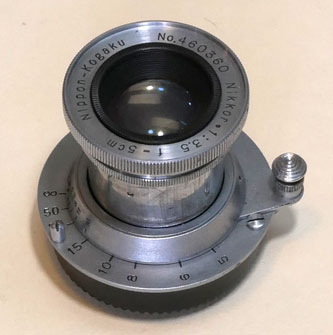
a Nikkor 5cm f3.5 lens from 1945 or 1946
Nikkor Lenses and Canon Cameras
From its earlies days, Seiki-Kōgaku Kenkyusho which was to become Canon Camera Company had a close relationship with Nippon Kōgaku, then the manufacturer of camera glass and its Nikkor lenses.
Seiki-Kōgaku's first camera was the Hansa Canon introduced into the Japanese market in February 1936. Seiki-Kōgaku did not yet have a sales outlet, and had a contract with Omiya Shashin Yohin Co., Ltd. (Omiya camera and accessory shop) (大宮フォトサプライ) which used the marketing name of "Hansa". They launched the Hansa Canon in 1936, with their Hansa name was engraved on the top of the camera.
The Canon rangefinder needed lenses for the 35mm format, and Nippon Kōgaku was able to fulfill that need. The Hansa Canon featured a Nikkor 5cm f3.5 lens which was bayonet mounted into a Nikkor focusing mounting.
The optical company Nippon Kōgaku Kogyo - 日本光学工業株式会社 or "Japan Optical Industries Co., Ltd." had been created in 1917 23 during World War I, aided by the Imperial Japanese Navy and the Mitsubishi group. 20 Nippon Kōgaku were not yet making cameras themselves. The later famous series of Nikon cameras was launched in 1948.
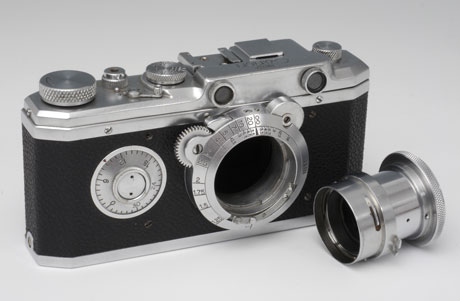
1936 Hansa Canon with 50mm f3.5 Nikkor lens removed from the Nikkor bayonet focusing mount
This Nikkor lens and its focusing mount was used on both the Hansa Canon, and its successor in late 1938, the Canon S. From this beginning, Nippon Kōgaku Kogyo provided the lenses for all later Canon cameras until Canon's own lens production began in 1946-1947. 2 Initially, the Nikkor 50mm f3.5 lenses were supplied to Seiki-Kōgaku in metal tubes to which Seiki-Kōgaku would add the appropriate lens mounting flange for mounting into the camera. Early versions of these Nikkor lenses had f-stops selected on the lens front. In 1936, the marked f-stop progression was the earlier progression then in use: f3.5, f4.5, f6.3, f9, f12.5, f18.
The Nikkor lenses came first in black faces and later in white faces.
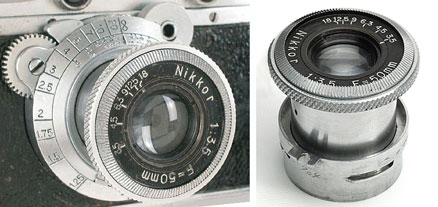
1936 or 1937 Hansa Canon black face Nikkor 5cm f3.5 lens without lens serial number
serial numbers were added to white-faced Nikkors during 1937 (read note below).

1937 Hansa Canon white face Nikkor 5cm f3.5 lens serial number 50556
Later Nikkor lenses had the f-stop selected by an aperture ring behind the front lens ring.
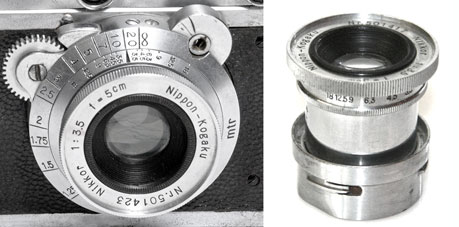
a Nikkor 5cm f3.5 lens bayonet-mount with the aperture ring behind the front lens ring
After 1941-1942 when the Nikkor focusing mount generally ceased to be used, each Nikkor lenses gained a helicoid focusing mount built into the lens body.
Development of Nikkor Lenses
John Baird in his most interesting book The Japanese Camera 20 wrote of the early development of Japanese lens development. Zeiss of Germany had private know-how and also patents, including in Japan on the production of optical glass and of lenses - particularly the Tessar design lens. He writes:
"...the Japanese Imperial Navy and Mitsubishi paid for these [licenses to German patents] as part of their support of Nippon Kogaku [in the early 1930s]... Nippon Kogaku had direct accessto Zeiss' designs, producing Tessar-type lenses such as the 5cm 1:3.5 Nikkor for the Hansa Canon in 1934." 20
Beyond the design and grinding/polishing of lens elements, a major difficulty for Japanese lens manufacture was the lack of domestically produced glass appropriate for camera lenses. Baird further writes:
"...Nippon Kogaku, with the help of the Japanese Navy was able to purchase overseas the basic materials and equipment required to produce new glass in Japan. Even so, the methods involved in the production of high grade optical glass in order to insure a homogenous and bubble-free mixture are very complex."
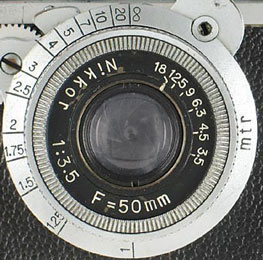
a 1935 Nikkor 5cm f3.5 lens for the Hansa Canon
Continuing his history, John Baird wrote:
"...Mr. Ryozo Furukawa worked... during the period of time when the 5cm 1:3.5 Nikkor was originally designed...He indicated that the first 5cm 1:3.5 Nikkor was completed in December 1934. Made entirely from glass melted at Nippon Kogaku, it was patterned after the Zeiss Tessar." 20
1935 Nikkor 5cm f3.5 lens was of 4 elements in 3 groups, just as the Zeiss Tessar.
John Baird also gives an interesting explanation for the Nikkor lens's black face-white face transition:
"...In January 1935, Mr Furukawa checked the performance of the then-new 5cm Nikkor lens against the Leitz Elmar and found the performance of the German optic better... Subsequent improvements in the optical glass allowed this superior-inferior situation to be rectified in May, 1937 when Nippon Kogaku improved the 5cm 1:3.5 Nikkor... It is suggested that the change of "black-faced" to "white-faced" Nikkors with serial numbers denotes this improvement" 20
The Nikkor 5cm f4.5 Lens
The 5cm f4.5 Nikkor was introduced late in 1937. This lens, like the Nikkor 5cm f3.5 before it was designed by Sunayama Kakuya - 砂山角野 chief designer of Nippon Kōgaku Kogyo, although he died in 1937 before the launch of this lens. John Baird 20 states that Sunayama was dissatisfied with the Nikkor 5cm f3.5, for the reasons described above. He therefore designed the sharp Nikkor 5cm f4.5. This lens from 1937 continued to be produced even in war-time conditions of World War II for supply to the Japanese military - particularly for the Imperial Navy which used this lens for close-up copy work, given its sharp image.

a 1939 Nikkor 5cm f4.5 lens
The Nikkor 5cm f2.0 Lens
Another Nikkor 5cm lens introduced during the Hansa Canon period was the Nikkor 5cm f2.0 lens. This design was based on the Zeiss 5cm f2.0 Sonnar. 20 The Zeiss Sonnar was of a Tessar design.
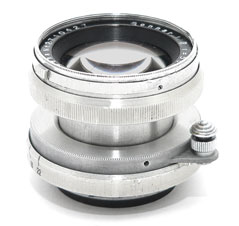
Zeiss Sonnar 5cm f2.0 collapsible lens
Unlike the Nikkor 5cm f3.5 and the Nikkor 5cm f4.5 which were made entirely from Japanese-produced glass melted at Nippon Kōgaku, the Nikkor f2.0 used special Schott barium glass imported from Germany. 20 The Nikkor 5cm f2.0 was of 6 elements in 2 groups, as was the Zeiss Sonnar. It is interesting that later tests of the Nikkor 5cm f2.0 found this lens superior in performance to the Zeiss 5cm f2.0 Sonnar on which it had been modeled. 20
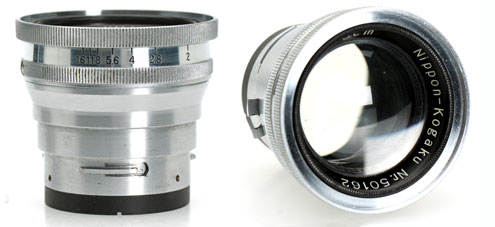
Nikkor 5cm f2.0 lens circa 1939 -1940
many (perhaps more than 100) Nikkor 5 cm f2.0 lenses were equipped during World War II on Canon S-I cameras for the Imperial Japanese Navy in bayonet mount
The earliest versions of the Nikkor 5cm f2.0 had f-stops set inside the front ring of the lens. Later versions, such as shown above, had the f-stop selection located on the barrel of the lens.
The Nikkor 5cm f2.8 Lens
What seems to be a particularly rare Nikkor 5cm lens introduced during the Hansa Canon period was the Nikkor 5cm f2.8 lens. Peter Dechert wrote that this lens was supplied only in a bayonet version. 1 In other words, this lens could be used on the Hansa Canon and the Canon S, but not on the later Canon models such as the Canon J which used screw-mount lenses with a helicoid focusing mount, instead of the Nikkor focusing mount of the Hansa Canon and Canon S.

Nikkor 5cm f2.8 lens with black face
This lens seems to have been produced only in small numbers, and examples almost never appear on secondary markets (and would likely fetch very high prices if they did appear). The black face f2.8 shown above was displayed at a Nikon symposium in Tokyo.
Nippon Kōgaku and Lens Coating
Following World II, the US Navy did extensive investigations of Japanese industry, including of Nippon Kōgaku. Particularly coprehensive was their research on Nippon Kōgaku's development of periscopes for submarines. They found "The standard 10-metre periscope produced by the company featured 33 individual optical elements..." 22 The light loss from so many surfaces, when uncoated, was significant. To improve light transmission, Nippon Kōgaku then experimented with lens coating techniques:
"According to the investigators in the U.S. Navy technical mission: In the evaporation method, cryolite is evaporated and deposited upon the glass surface, in vacuum. After treatment, the glass is baked at 150°C for one hour for durability. 22
Whether or not Nippon Kōgaku used this particular technique with camera lenses, beginning in 1946, they began coating the 5cm f3.5 Nikkor lens. 20 Lenses with this coating gained a red dot on the front ring of the camera.

Nikkor 5cm f3.5 coated lens of 1946 with red dot indicating a coated lens
The Central Role of Nippon Kōgaku in Canon Rangefinder Development
As can be seen from the descriptions above, Nippon Kōgaku was central in the early development of Seiki-Kōgaku and the Canon rangefinder camera. Nippon Kōgaku provided all the lenses, it manufactured the adjustable lens mount, and it designed the rangefinder mechanism. Also, Nippon Kōgaku continued to provide all the Canon lenses until Canon began manufacture of its own lenses in late 1946. In fact it was only in 1947 that Canon produced its lenses in significant quantities.
And, of course, Nippon Kōgaku was later, in 1948, to introduce the first of a distinguished line of Nikon cameras, greatly enhanced by the long series of fine Nikon lenses which accompanied them.
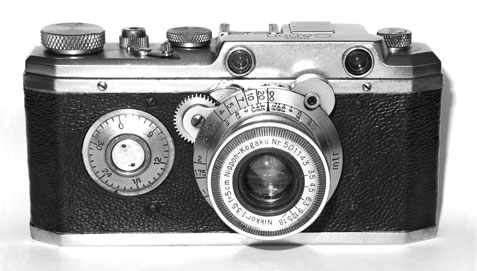
a 1938 white face Nikkor 5cm f3.5 lens on Hansa Canon
You can click on the links in the table below to consult other pages of the canonrangfinder.org site.
| Navigation: Click Below to Jump to Desired Subject Page | ||
|---|---|---|
| Canon Rangefinder Cameras - 1 | Canon Rangefinder Cameras - 2 | Canon Rangefinder Lenses |
| Canon Hansa | Canon IIAF, IIAX | Development Nikkor 50mm |
| Canon S | Canon IVSB2 | Canon 19mm |
| Canon J | Canon IIS2, IID2, IIF2 | Canon 25mm |
| Canon NS | Canon VT, Canon L2 | Canon 28mm |
| Canon JS | Canon L1, L3 | Canon 35mm |
| Canon S-I | Canon VT Deluxe | Canon 50mm |
| Canon J-II | Canon VL, VL2 | Canon 85mm |
| Canon S-II | Canon VI-L, VI-T | Canon 100mm |
| Canon IIB | Canon P | Canon 135mm |
| Canon III, IIC, IV | Canon 7 | Canon 200mm-1000mm |
| Canon IIIA, IVF, IVS | Canon 7s | Canon Accessories |
| Canon IIA, IID, IID1 | Nicca Rangefinders | Canon Finders |
| Canon IVSB | Minolta Rangefinders | Minolta Lenses |
| Canon IIF, IIS | Other Rangefinders | other M39 lenses |
| Go to canonrangefinder.com home page | ||
Any additions or corrections to these pages would be welcome simply by contacting this site as shown at the foot of this page .
Footnotes:
1 Dechert, Peter. Canon Rangefinder Cameras 1933-1968. Hove Collectors Books. West Sussex, United Kingdom. 1985. ISBN 0-906447-30-5.
Peter Dechert's book is the most important expert source of information regarding Canon Rangefinder Cameras.
2 Kitchingman, Peter. Canon M39 Rangefinder Lenses 1939-1971. A Collector's Guide. Published by Peter Kitchingman. Perth, Australia. 2008. ISBN 978-0-646-48144-9.
Peter Kitchingman's book is the definitive study of the more than three decades of M39 format camera lenses developed for Canon Rangefinder Cameras.
3 Nostalgic Canon Camera Book. 懐かしいキヤノン EI Publishing Co. Ltd. Tokyo, Japan. June 2003.
Peter Kitchingman's book is the definitive study of the more than three decades of M39 format camera lenses developed for Canon Rangefinder Cameras.
4 "Canon Camera Museum" history website. https://global.canon/en/c-museum/history/ published by Canon, Inc. accessed in 2019.
5 Rajner, Hans P. (author), John Wade (editor). Leica Copies. Classic Collections Publications. London, UK. ISBN 13: 9781874485056
Hans P. Rajner's book is an excellently detailed and carefully researched study of camera from around the world which used the Leica M39 lens mount and the same lens to film plane distance.
7 Dechert, Peter. Canon Single Lens Reflex Cameras 1959-1991. Historical Camera Publications. Yakima, Washington. 1992. ISBN 1-879561-04-2.
8 Tomlinson, Shawn M. The Film Photography Book. Lulu Pulbications. 2016. ISBN: 9781365263972
9 Sartorius., Ghester. Identifying Leica Lenses. Classic Camera 19. Tokyo, Japan. 2001. ISBN 4-257-12029-0
10 website http://www.nicovandijk.net/rflensmatrix.htm consulted 2019.
11 O'Reagan, Douglas M. Allied Exploitation of German Science after World War II. Johns Hopkins University Press. Baltimore, Maryland. 2019. ISBN 9781421428888
12 website www.canonrangefinder.servehttp.com consulted 2008.
13 Minolta expert Andrea Aprà has posted information on minoltarangefinders group and other groups and further detailed information by email. (thanks Andrea !)
14 website http://www.collection-appareils.fr/objectifs/ consulted 2019.
15 Small, Marc James. Non-Leitz Leica Thread-Mount Lenses. Wittig Books. Hückelhoven, Germany. 1997. ISBN 3-930359-47-2.
16 the Nikon Corporation website: https://imaging.nikon.com/history/ consulted 2019.
17 p 152. Ray, Sidney F. Photographic Lens ISBN 9780240510323
18 website http://www.rokkorfiles.com/Lens%20History.html accessed 2019
19 Katz, Jerome. The Kardon camera story: a dedication to Peter Kardon, great American patriot & pioneer. SJF Enterprises. New York, New York. 1977.
20 Baird, John. The Japaneese Camera. The History of the Japanese Camera Monograph Collection. Historical Camera Publications. Yakima, Washington. 1990. ISBN 1-879561-02-6.
21 interesting website http://www.topgabacho.jp/Topconclub/Leotax.htm accessed 2019
22 Alexander, Jeffrey Scott. Nikon and the sponsorship of Japan's optical industry by the Imperial Japanese Navy 1923-1945. MA Thesis. University of British Columbia. 2001.
23 Alexander, Jeffrey Scott. Nikon and the sponsorship of Japan's optical industry by the Imperial Japanese Navy 1923-1945. PhD Thesis. University of British Columbia. 2010.
24 Lewis, Gordon, editor. Fujimura, Amy and Fujimura, William, translators. The History of the Japanese Camera. International Museum of Photography at George Eastman House. Tokyo and Rochester. 1991. ISBN 0-935398-17-1.
If you have any comments or questions about this Leopold Stokowski site, please e-mail me (Larry Huffman) at e-mail address: [email protected]